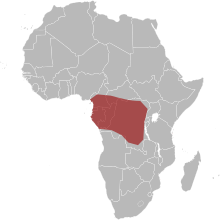Many-banded snake
| Many-banded snake | |
|---|---|
| Scientific classification | |
| Domain: | Eukaryota |
| Kingdom: | Animalia |
| Phylum: | Chordata |
| Class: | Reptilia |
| Order: | Squamata |
| Suborder: | Serpentes |
| Family: | Elapidae |
| Genus: | Naja |
| Subgenus: | Boulengerina |
| Species: | N. multifasciata |
| Binomial name | |
| Naja multifasciata (F. Werner, 1902) | |
 | |
| distribution | |
| Synonyms[2] | |
The many-banded snake (Naja multifasciata), also known commonly as the burrowing cobra, is a species of venomous snake in the family Elapidae. The species is native to Central Africa. There are three recognized subspecies.
Geographic range
[edit]N. multifasciata is found in Angola, Cameroon, the Democratic Republic of Congo, Equatorial Guinea, Gabon, the Republic of Congo,[1][2] and the Central African Republic.[1][3]
Habitat
[edit]The preferred natural habitat of N. multifasciata is marshy areas of forest, at elevations up to 800 m (2,600 ft).[1]
Description
[edit]N. multifasciata is a small snake with an adult size of 50 cm (20 in) and maximum size of about 81 cm (32 in). The body is moderately slender with a short tail ending in a blunt spike. The head is short, flattened, and slightly distinct from neck; the neck region is not capable of expansion into a hood. The eyes are medium to moderately large. The pupils are round. The dorsal scales are smooth and glossy.[3]
Venom
[edit]N. multifasciata is venomous.[2][4] Its venom is similar to classical cobra venoms and appears to contain both neurotoxins and cardiotoxins.[4]
Reproduction
[edit]N. multifasciata is oviparous.[2]
Taxonomy
[edit]The genus Paranaja was synonymised with Naja in a recent molecular phylogenetic study, as this species is closely related to the forest cobra (Naja melanoleuca) [5]
Subspecies
[edit]Three subspecies are recognized as being valid, including the nominotypical subspecies.[2]
- Naja multifasciata anomala Sternfeld, 1917 – Cameroon
- Naja multifasciata duttoni (Boulenger, 1904)
- Naja multifasciata multifasciata (F. Werner, 1902)
Nota bene: A trinomial authority in parentheses indicates that the subspecies was originally described in a genus other than Naja.
Etymology
[edit]The subspecific name, duttoni, is in honor of British parasitologist Joseph Everett Dutton.[6]
References
[edit]- ^ a b c d Kusamba, C.; Chirio, L.; Gonwouo, N.L.; Zassi-Boulou, A.-G. (2021). "Naja multifasciata". IUCN Red List of Threatened Species. 2021: e.T110168688A110168696. doi:10.2305/IUCN.UK.2021-1.RLTS.T110168688A110168696.en. Retrieved 18 November 2021.
- ^ a b c d e Naja multifasciata at the Reptarium.cz Reptile Database
- ^ a b "Naja multifasciata". Clinical Toxinology Resources. University of Adelaide. Retrieved 8 March 2023.
- ^ a b Harvey, Alan L.; Rowan, Edward G.; Theakston, R. David G.; Warrell, David A. (2012). "First pharmacological study of the venom of a rare African snake, Naja multifasciata duttoni". Toxicon. 60 (2): 174. doi:10.1016/j.toxicon.2012.04.155.
- ^ Wüster W, Crookes S, Ineich I, Mané Y, Pook CE, Trape J-F, Broadley DG (2007). "The phylogeny of cobras inferred from mitochondrial DNA sequences: evolution of venom spitting and the phylogeography of the African spitting cobras (Serpentes: Elapidae: Naja nigricollis complex)". Molecular Phylogenetics and Evolution 45: 437–453.
- ^ Boulenger GA (1904).
Further reading
[edit]- Boulenger GA (1904). "Descriptions of Two new Elapine Snakes from the Congo". Annals and Magazine of Natural History, Seventh Series 14: 14–15. (Elapechis duttoni, new species, p. 15).
- Sternfeld R (1917). "Reptilia und Amphibia". pp. 407–510 + Plates XXII–XXIV. In: Schubotz H (editor) (1917). Wissenschaftliche Ergebnisse der Zweiten Deutschen Zentral-Afrika-Expedition, 1910–1911 unter Führung Adolph Friedrichs, Herzog zu Mecklenburg. Band 1, Zoologie. Leipzig: Klinkhardt & Biermann. 597 pp. + Plates I–XXVII. (Naja anomala, new species, pp. 482–484 + Plate XXIV, figure 9). (in German).
- Trape J-F, Roux-Estève R (1995). "Les serpents du Congo: liste commentée et clé de détermination [= Snakes of the Congo: Annotated List and Identification Key]". Journal of African Zoology 109 (1): 31–50. (in French).
- Werner F (1902). "Ueber westafrikanische Reptilien ". Verhandlungen der kaiserlich-königlichen zoologisch-botanischen Gesellschaft in Wien 52: 332–348. (Naia multifasciata, new species, p. 347). (in German).


 French
French Deutsch
Deutsch